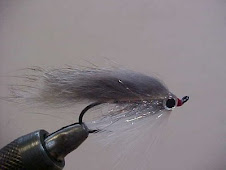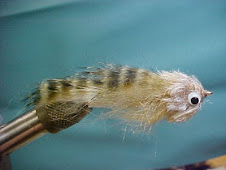
Winter Trout Tactics
written by Jason Akl
This winter season could be a fly angler's best opportunity of the year to catch a true trophy-sized trout.
Very cold water temperatures will negatively affect the feeding habits of large trout.
For many fly anglers the winter season foretells long hours behind the tying vice with little or no time spent fishing their favorite waters. This transition away from fishing is primarily due to the fact that with the shorting of sunlight light hours comes chilling breezes, snow and ice. The idea of standing out in the middle of a river with snowflakes falling and ice chunks stacking up along the shores is unbearable even for the most stubborn of anglers. With a bit of careful planning combined with warm clothing, winter can provide some excellent fly fishing action. In all actuality this winter season can be a fly angler's best opportunity of the year to catch a true trophy-sized trout. This special opportunity comes about due to the fact that the harsh weather will significantly decrease the amount of fishing pressure these rivers and fish receive. On the same note the cold weather also limits the number of aquatic insects hatching off of these fertile bodies of water, decreasing the amount of available food for hungry fish.
Winter Water Temperature
Even though you are planning on pursuing a game fish that is known to be cold blooded, water temperature is still a very important consideration for anglers. Very cold water temperatures will negatively affect the feeding habits of large trout. This cold water temperature will slow the fish's metabolism dramatically curbing the desire to eat any tasty morsel that crosses their path. In addition to this, the cold water conditions will push fish to deeper spots in the river where the best opportunity for food will be found. Fishing success in this cold water depends firmly on the depth and speed of your fly presentation. Flies need to get down deep to the fish's level quickly and stay in this strike zone for as long as possible. A good idea for fishing these frigid conditions is to start the days fishing late in the afternoon. Allowing the sun to rise high overhead will warm things up outside tremendously, making your day of fishing much more comfortable.
Flies
During this cold winter season the number of actual hatches that take place is minimal unless the winter is a mild one. More often than not the critters you will find in the stream this time of
Streamers and leech patterns are an excellent choice for fishing extremely cold waters that limit aquatic insect.
year will be in the nymph or larval stage of their respective lifecycle meaning that they can be found clinging or crawling around on the bottom of the river rocks. Using general imitation nymph-style patterns will be the most productive flies for anglers because these patterns will closely imitate many of the different types of caddis and stoneflies found on the bottom. If an angler is really not sure what types of aquatic critters are inhabiting the stream in which they are going to be fishing, then taking a few seconds to flip over a few rocks and see what is hiding below is a good place to start. Carrying a few small dry flies is another good idea when fishing these winter waters. Every now and then when the temperature spikes during the mid-afternoon, hatches will take place. Keep in mind these hatches will not be huge numbers of flies coming off the water or keep hatching for very long, so getting your fly tied on quickly and in the path of feeding fish is imperative.
Even though primarily you will be using nymph patterns, carrying a few large baitfish streamers is a good idea. Streamers and leech patterns are an excellent choice for fishing extremely cold waters that limit aquatic insect activity or if the water conditions are discolored or stained. Trout are gluttonous cannibals and have no problems eating large baitfish streamers drifted slowly though deep runs or pools in the river.
Equipment
For winter fishing on small or moderate-sized lakes and rivers, a full floating line is all that is required. Floating lines are designed to present dries to fish while at the same time these lines can also be used to fish weighted nymph patterns to fish holding in deeper pools. If you come across a deep fast pool, ordinary-weighted flies will not necessarily get down to fish. Adding a little extra external weight to the fly line in the form of a splitshot should do the trick. Since winter trout can be especially spooked using long leaders coupled to light tippets will only increase your chances of hooking up with fish. Fly rod selection for winter fishing for the most part follows the same rules as summer fishing. Longer rods (8 1/2 or 9 foot) are ideal for nymphing techniques, but if the banks on the river you are planning on fishing are overgrown with trees and brush then shorter rods have to be used. Overall a 9-foot, 5-weight rod should adequately handle almost any winter situation you run into, but if you are looking to get out on larger waters that might be subject to a few gusty breezes then sizing up a weight or two is not a bad idea.
For winter fishing on small or moderate-sized lakes and rivers, a full floating line is all that is required.
Presentation
Winter nymphing success depends on two general principals: getting flies down deep, and working these patterns slowly along the bottom. The normal up and across technique is used in winter-nymphing to get the flies where you want them, while appropriate line mending will keep the fly drifting downstream as natural as possible. Strikes from fish on nymphs this time of year will be very light and subtle. Using some sort of strike detection system is advised to increase your chances of setting the hook on fish. While nymphing, be adamant about fishing every pool and pocket from as many different angles as possible. Start fishing the pool from the bottom to the top, then use a downstream approach and finally finish up fishing the pool side-to-side. Winter trout can be a very weary group of fish and even though you have fished over a hole thoroughly, a simple change of flies and starting over can produce bites.
If you do not receive any action on nymphs try switching to streamer patterns like a leech or minnow imitation fished with a down and across pattern. Cast the fly to a position above the target and allow the fly to sink to the required depth before reaching the fish. On the first pass allow the streamer to drift downstream naturally and swing at the end of the drift to a position directly below the angler. This dead-drifting, tumbling motion resembles a dead or wounded minnow being swept downstream with the current while the swing motion at the end of the cast simulates the wounded minnow trying to flee danger. On the second pass, actively strip the fly against the current to try and get lackadaisical fish to react.
If you do get lucky enough to come across a midge or caddis hatch during the cold winter months chances are the bugs hatching will be small (these flies will be approximately the same size as fly patterns in the size 16 and 20 range) so be prepared. As you fish, watch the water and the surrounding environment for flies rising off the water or returning to lay eggs. These flies will be sparse and fish will sip quietly so the sooner you figure out that the hatch has begun the better odds you will have at hooking up with fish.
Winter Safety
Although the splendors of winter fly fishing can be great, the downfalls can be tragic. Slipping or falling into an ice cold river can mean more than just frost bit fingers and toes; it can be fatal. Careful observation of the weather and water you are going to be fishing is a must. Pay close attention to weather reports and never try to fish ahead of a winter front. Winter conditions can change very rapidly and you could possibly get stuck out in very cold conditions if you are not prepared for them. Rivers bottoms at this time of the year can be very soft so wade carefully and only go as deep as absolutely necessary. If you cannot figure out a safe path to reach your respective target then by passing it over is your only option. A key concept to winter fishing like all other winter sports is trying to dress appropriately for the conditions. Always dress in layers and prepare for the worst. If the weather outside happens to get warm, then simply taking a few layers off will cool you down. Try and wear fabrics that wick away moisture from the skin. All that walking will make you sweat and the drier you stay the warmer you will be. Under garments made of wicking materials such as polypropylene is a must. Wool or fleece is a good choice for fabrics and an extra hat and pair of gloves will keep you warm and comfortable so that you can fish longer.
Winter fly fishing is not meant to be just for die-hard anglers willing to wade through ice-covered rivers in the middle of a blizzard. Proper planning, dress and technique will allow even the beginner winter fly angler to be successful and turn some of those winter blues into Browns, and hopefully big ones at that.











